Introduction
Foliage management is an important activity for stone fruit production. It helps to preserve the health of orchards and secure the production of high-quality fruit to meet early-season, high-value markets. However, this task presents unique challenges for peach growers in Florida. The warm and humid subtropical climate during Florida’s growing season creates ideal growth conditions for fungal and bacterial diseases, such as peach leaf rust and bacterial spot, making disease control difficult. High disease pressure on the canopy often results in premature defoliation, which can negatively impact fruit production.
Low-chill peach cultivars grown under subtropical conditions retain leaves into late fall. If leaves do not senesce and drop, chilling accumulation can be negatively impacted. Chilling accumulation is a crucial process that allows buds to break dormancy and bloom in the following season. Understanding dormancy and properly preparing trees for this stage is vital for successful subtropical peach production.
This publication addresses key aspects of dormancy, the impact of chilling accumulation, and the importance of timing for defoliation practices in low-chill peach orchards growing under subtropical climates. This information is intended for county and state Extension faculty, growers, and homeowners interested in peach production in Florida.
Types of Dormancy
Dormancy, or resting period, is a natural process that occurs in perennial tree species and helps plants survive the winter by preventing potential damage from low temperatures. Dormancy is generally characterized by leaf drop and the absence of visible growth. There are three types of dormancy, generally occurring in sequence:
- Para-dormancy: This refers to the absence of growth in lateral buds due to the presence of an apical meristem. Para-dormancy is also known as apical dominance. It occurs during the growing season, when the apical bud actively promotes the elongation of the shoot and prevents lateral buds from growing, thus keeping them in a dormant state.
- Endo-dormancy: This refers to the absence of growth due to internal regulatory mechanisms in the bud, which prevent growth even under favorable environmental conditions. To break endo-dormancy, buds need to be exposed to a certain period of low temperatures (depending on the species and cultivar) in a process known as chilling accumulation.
- Eco-dormancy: This refers to the dormant status observed in buds in response to unfavorable environmental conditions. Generally, eco-dormancy occurs after trees have broken the endo-dormant status by satisfying their chilling requirements and when ambient temperatures are not high enough for buds to satisfy their heat requirements (period of exposure to warm temperatures required for blooming).
In other words, para-dormancy, endo-dormancy, and eco-dormancy are part of the mechanism that allows perennial trees to synchronize flowering time (Figure 1) with the spring season, preventing potential damage in flowers and young leaves due to the low winter temperatures.
Understanding Chilling Requirements
Chilling requirement refers to the period of exposure to low temperatures required by the buds of most temperate fruit trees to break endo-dormancy and prepare for blooming. Chilling requirement is a physiological mechanism that allows plants to flower when the environmental conditions are more suitable, helping them reduce the probability of cold damage in the flowers due to potential freezing events. Generally, temperatures between 32°F (0°C) and 45°F (7°C) are considered optimal to “accumulate” chilling and satisfy the chilling requirement. One hour within this range is called a “chilling hour” or “chill unit.” However, temperatures below 32°F provide little to no chilling hours, while prolonged periods above 60°F (15°C) can negatively affect chilling accumulation.
The chilling requirement of a specific peach cultivar is an important characteristic for growers to consider when selecting their trees. Based on this, peaches can be classified as low- (less than 250 chill units), medium- (between 300 and 525 chill units), or high-chill (more than 525 chill units) requirement cultivars. Low-chill cultivars are used to establish commercial orchards in Florida since chilling periods in the state (particularly in the central region, where most commercial peach orchards are located) are limited and have continued to decrease as a result of climate change and global warming.
Chilling requirements can vary among peach cultivars, potentially delaying or advancing the harvest time and consequently impacting the desired early market for Florida peach growers. Therefore, the chilling requirement of a cultivar and the specific environmental conditions of a particular location should be considered when selecting plant material to establish a commercial orchard.
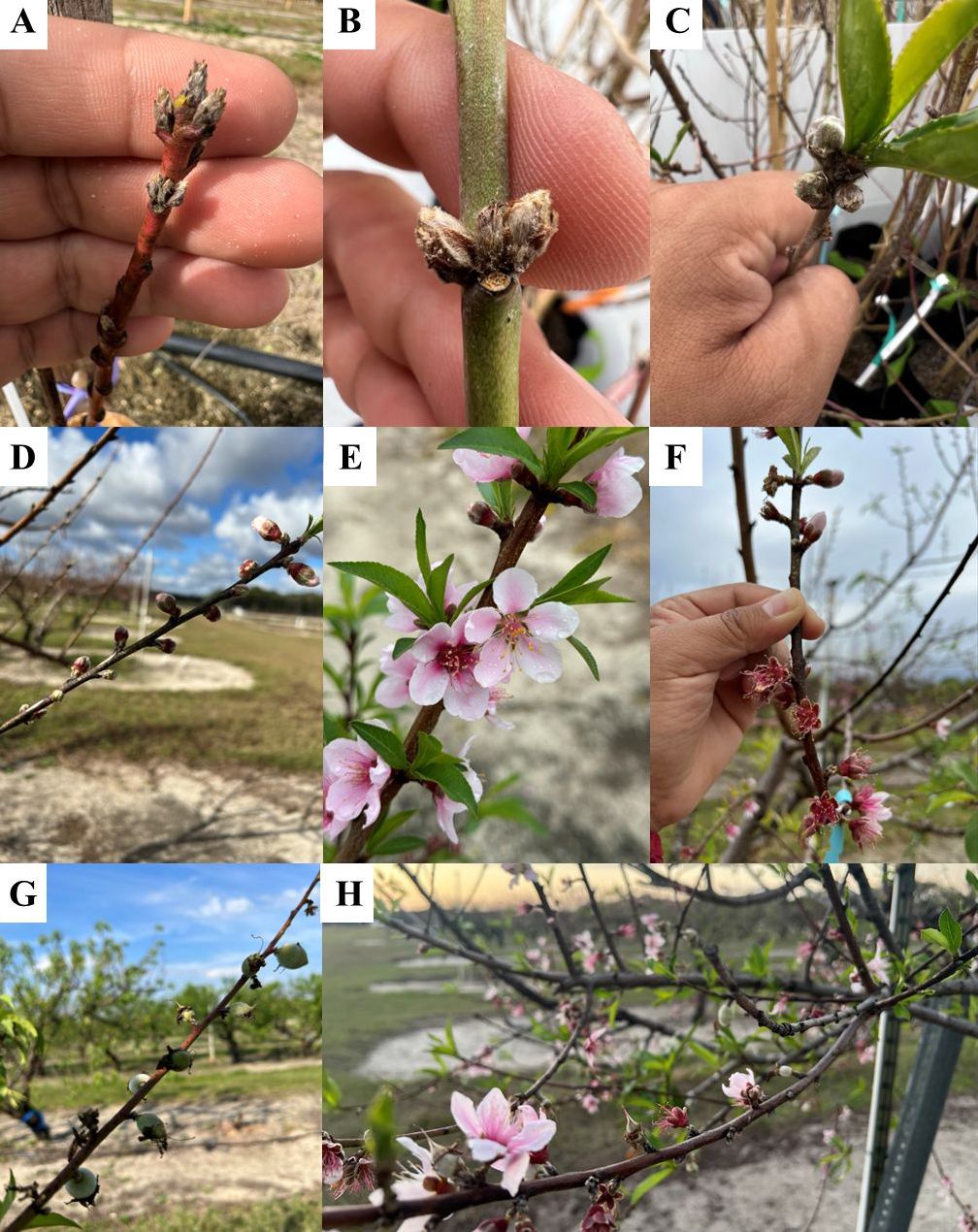
Credit: Jonathan Clavijo-Herrera, UF/IFAS
Chilling Accumulation Period
The chilling accumulation window in southern locations is narrow, making peach commercial production difficult. In central Florida, the chilling accumulation period starts the last week of October and lasts until early March. Ideally, chilling accumulation in this region should occur between early December and mid-January, which would allow fruit to be harvested before mid-May and avoid competition with northern states' fruit entering the market. Chilling accumulation periods that occurred after mid-January do not necessarily benefit commercial production. If the chilling accumulated for a cultivar is adequate, full bloom in peach orchards located in central Florida should be observed between the third week of January and early February. Usually, Florida peaches ripen between mid-March and mid-May, depending on the cultivar’s fruit developmental period (i.e., the time required to reach maturity after fruit set).
In the north-central region, such as Marion County (Figure 2A), chilling accumulation usually occurs between late November and January, with flowering occurring by early February. In the south-central region, such as De Soto County (Figure 2B), those periods are registered between early December and January, with flowering starting by mid-January if enough chilling is accumulated. It is important to mention that chilling periods in recent years have significantly decreased when compared to historic averages (Figure 2), particularly in southern regions of Florida. Chilling periods that occur once flowering is initiated are not effective in fulfilling the chilling requirements of a peach tree.
High- and low-chill peach cultivars show different responses to inadequate chilling accumulation. Insufficient chilling accumulation causes flower bud abortion in high-chill cultivars, whereas abortion is observed in low-chill cultivars if exposed to excessively long chilling periods. Dormancy depth, the level of dormancy of a tree at a specific time, has also been reported to be lower in low-chill cultivars compared to high-chill cultivars. The deeper the dormancy level, the longer the flower buds must be exposed to optimal growing conditions to bloom. Thus, low-chill cultivars require less exposure to optimal temperature conditions to bloom than high-chill cultivars.
Why is defoliation important?
In northern states, peach defoliation occurs naturally in late fall–early winter as a result of shorter days and lower temperatures. In subtropical climates, peach trees tend to retain their leaves, and natural defoliation occurs late, after the chill accumulation period has already started. If leaves do not detach from trees before the chilling accumulation period, endo-dormancy is prevented. Moreover, flower buds will not be receptive to chill accumulation because leaves act as an inhibitory agent for proper bud development and flowering. Even if the peach trees produce flowers and set fruit, fruit production will not reach a commercial value. However, low-chill peach trees that defoliated early in the winter can reach high flowering levels and mitigate the development of abnormal flowers, resulting in high commercial fruit yields. On the other hand, a delay in defoliation can also delay flowering and promote the development of larger fruit. This could help growers adjust the flowering period to reduce the risk of freeze damage if prolonged winters are expected. Consequently, timely defoliation of low-chill peaches growing under subtropical climates can help trees produce high yields.
Appropriate Timing for Defoliation in Subtropical Peach Orchards
Defoliation, as a management practice to secure adequate flowering and fruit production in subtropical peach orchards, is highly sensitive to timing. In nature, the timeframe for natural defoliation can vary by more than 10 days from one season to another, and it can take up to 30 days to reach full defoliation. If trees are prematurely defoliated, buds will not have enough time to develop properly, thus generating deformed reproductive structures and causing bud abortion, even if buds are exposed to sufficient chilling periods. Moreover, premature defoliation will reduce the amount of carbohydrates and nitrogen-based compound reserves accumulated to sustain the following season’s flowering, causing erratic fruit set and poor yields. As previously mentioned, flowers may still grow and develop if trees defoliate late, but yields can be significantly reduced.
Additionally, summer pruning is a management practice in Florida peach orchards to control tree size, typically performed after harvest. After summer pruning, it can take between four and five months for trees to develop the vegetative and reproductive structures required for the following spring flowering. Therefore, under Florida conditions, peach tree defoliation should be conducted in late November, when nighttime temperatures typically drop below 50°F. By this time, trees have had sufficient time to develop vegetative and reproductive structures and store carbohydrates for the following spring.
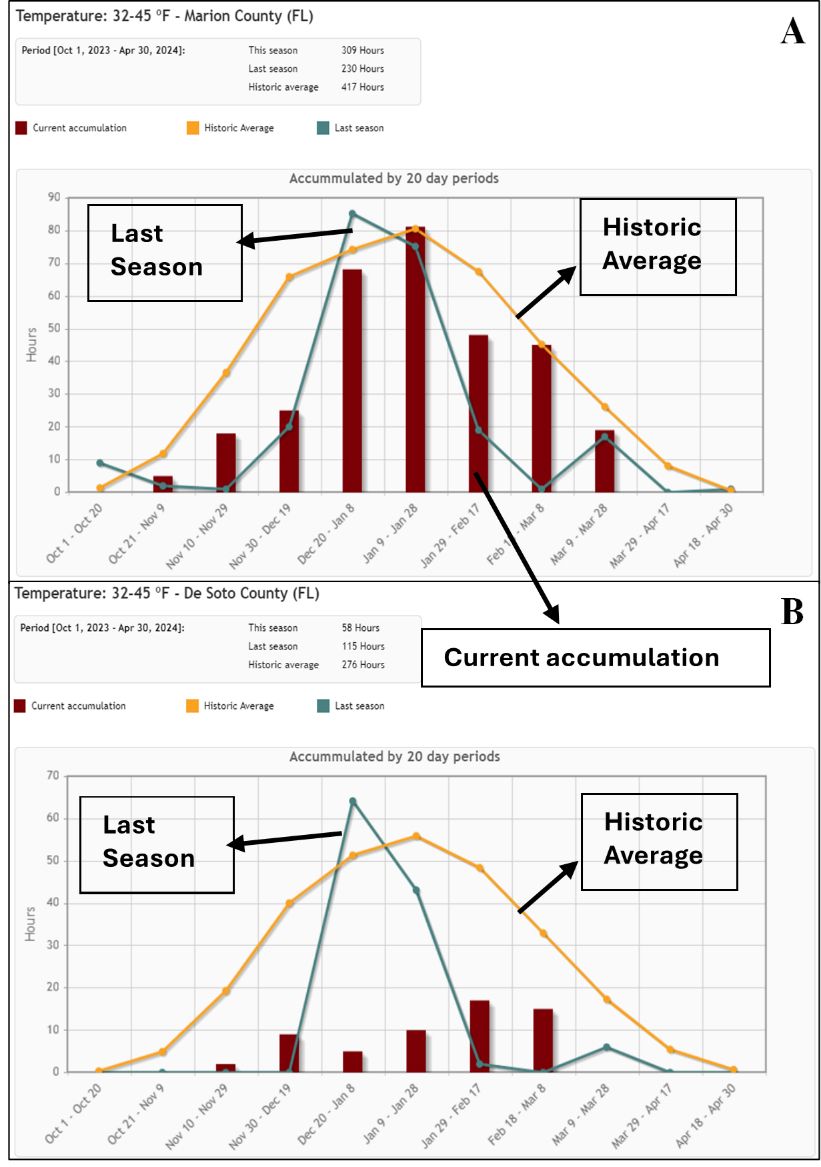
Credit: Adapted from agroclimate.org
How to Properly Defoliate Peach Trees
Several agricultural products can be used to defoliate trees artificially (Figure 3). However, it is critical to have information about the product to be used, as it could cause damage to the trees or undesired effects on flowering time, fruit quality, or yield. Furthermore, reading the label is important to ensure safe manipulation of the product and prevention of hazardous situations. Copper sulfate or zinc sulfate have been successfully used for defoliation in peaches and are commercially available. Considering that zinc deficiency is commonly reported in Florida peach orchards due to Florida's sandy soils, defoliation using zinc sulfate as foliar spray is recommended in the state (Figure 4). After foliar application of zinc sulfate, part of the zinc is translocated from the leaves to the buds, which helps to prevent potential zinc deficiencies that could endanger the next season’s flower and fruit development. For successful defoliation, a zinc sulfate concentration between 10 to 15 lb per 100 gal of water per acre is recommended. Warm water facilitates the dissolving of zinc sulfate, so it is recommended to make a preliminary dilution of the product in warm water before mixing it in the tank. Zinc sulfate is highly corrosive; consequently, the equipment used in the application should be immediately and thoroughly rinsed. For large orchards, an air blast sprayer can facilitate the application (Figure 5A). In small-scale operations, backpack (Figure 5B) or hand sprayers (Figure 5C) are alternatives. For backyard growers, foliar applications may not be necessary, and hand defoliation is recommended. Foliar applications of agricultural products should be performed on clear days, with low winds and no rainy periods. Leaves with a high nitrogen content may require additional rounds of spray to achieve full defoliation, so consider supplementary applications if needed.
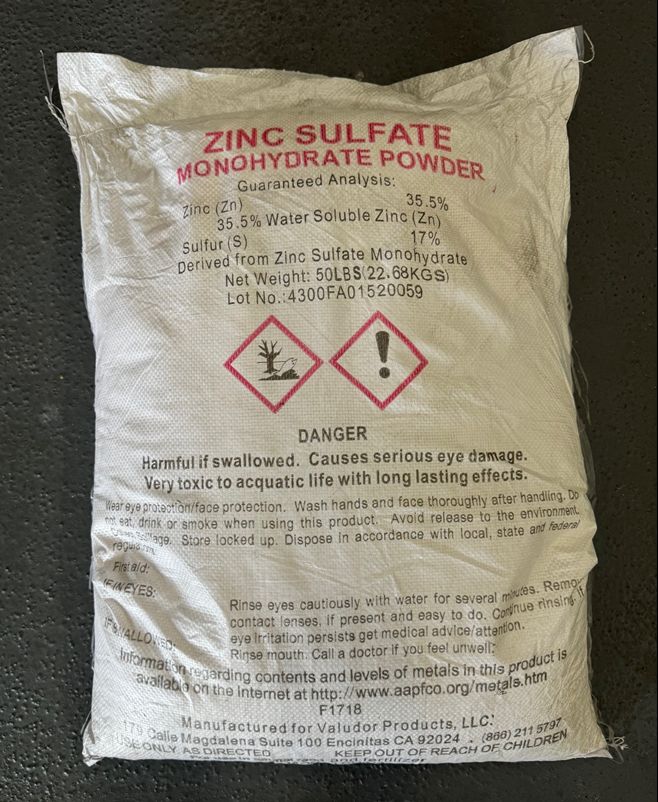
Jonathan Clavijo-Herrera, UF/IFAS
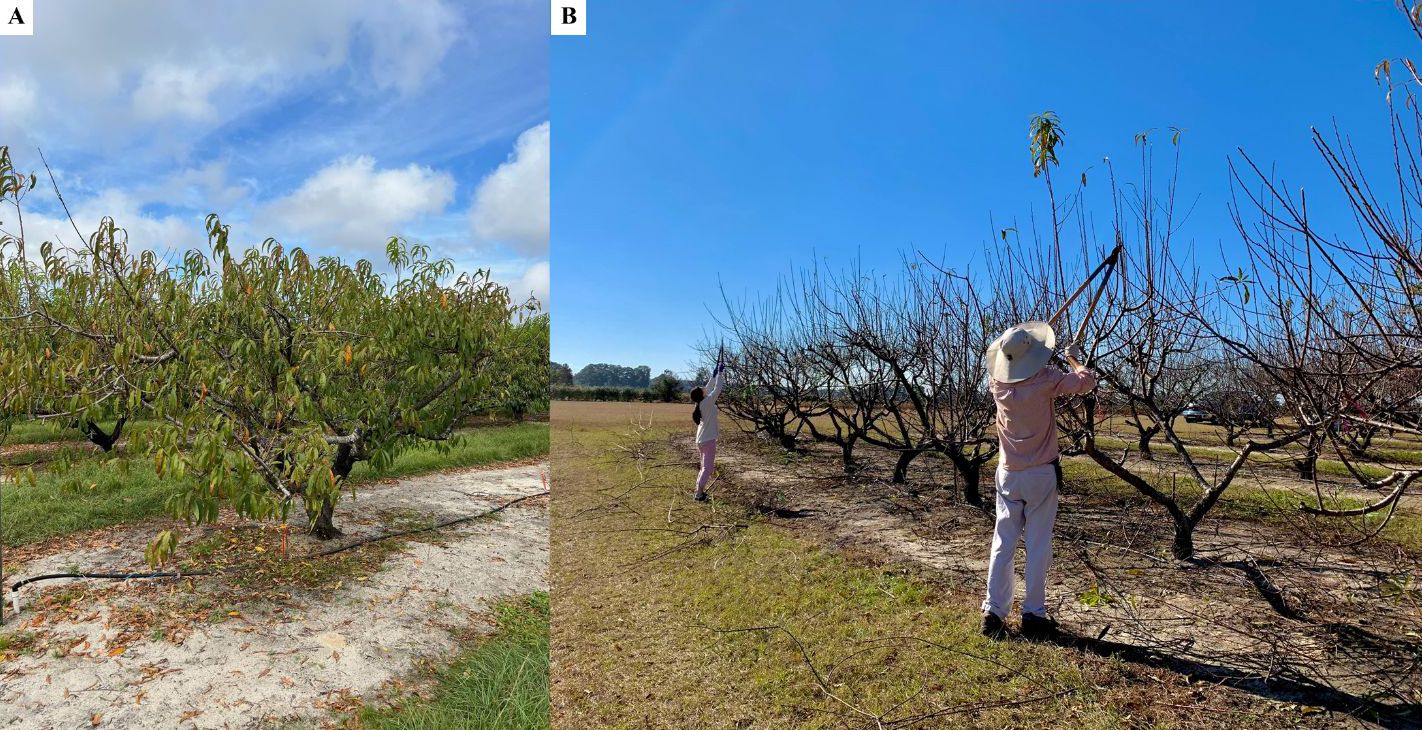
Credit: Jonathan Clavijo-Herrera, UF/IFAS
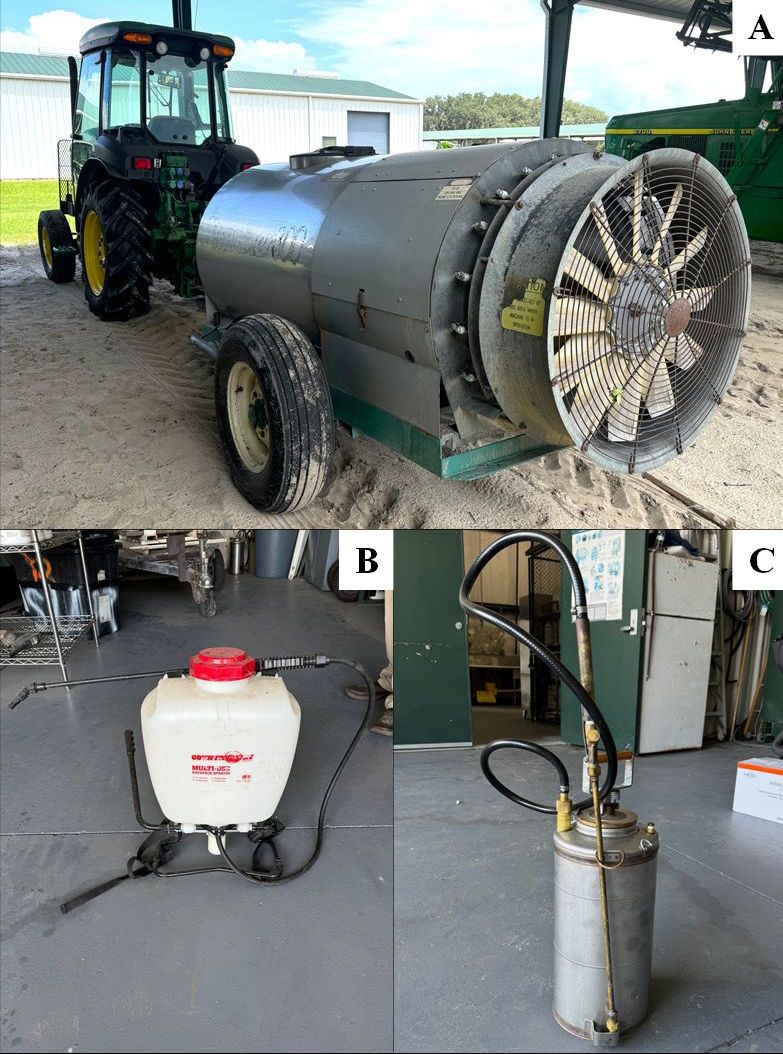
Credit: Jonathan Clavijo-Herrera, UF/IFAS
Conclusion
Defoliation is an important management practice that helps trees to enter dormancy and reduces the risk of freeze damage. Additionally, defoliation helps to synchronize flowering and fruit ripening for the next season, resulting in high-quality fruit and the achievement of commercial yields. Ideally, defoliation should be performed by the last week of November for fruit to be ready for the early peach season harvest window, before northern states enter the market. In Florida, zinc sulfate is recommended for defoliation, as it also helps mitigate potential zinc deficiencies. Timely defoliation is critical for the commercial production of low-chill peach cultivars growing under humid subtropical climates.
Further Reading
AgroClimate. n.d. AgroClimate: Tools for Managing Climate Risk in Agriculture. Southeast Climate Consortium, University of Florida. Accessed on August 14, 2024. http://agroclimate.org
Fuss, A. M., P. M. Burne, B. G. Coombe, and M. Sedgley. 1990. “Cultural Manipulation for Out-of-Season Peach Production Under Glass.” Scientia Horticulturae 43 (1–2): 15–27. https://doi.org/10.1016/0304-4238(90)90032-A
Gariglio, N., M. Weber, M. Perreta, et al. 2012. “Chemicals Applied in Fall and Defoliation on Dormancy Evolution and Release in Low-Chill Peach ‘Flordaking’.” Agrociencia Uruguay 16 (2): 49–59. https://doi.org/10.31285/AGRO.17.538
Jones, D. L., D. G. Nichols, W. K. Thompson, and L. A. Jager. 1973. “Chemical Defoliation of Deciduous Nursery Plants.” Australian Journal of Experimental Agriculture and Animal Husbandry 13 (63): 460–464. https://doi.org/10.1071/EA9730460
Lang, G. A., J. D. Early, G. C. Martin, and R. L. Darnell. 1987. “Endo-, Para-, and Ecodormancy: Physiological Terminology and Classification for Dormancy Research.” HortScience 22 (3): 371–377. https://doi.org/10.21273/HORTSCI.22.3.371
Lloyd, J., and D. Firth. 1990. “Effect of Defoliation Time on Depth of Dormancy and Bloom Time for Low-Chill Peaches.” HortScience 25 (12): 1575–1578. https://doi.org/10.21273/HORTSCI.25.12.1575
Malyshev, A. V. 2020. “Warming events advance or delay spring phenology by affecting bud dormancy depth in trees.” Frontiers in Plant Science 11: 856. https://doi.org/10.3389/fpls.2020.00856
Mounzer, O. H., W. Conejero, E. Nicolás, et al. 2008. “Growth Pattern and Phenological Stages of Early-Maturing Peach Trees Under a Mediterranean Climate.” HortScience 43 (6): 1813–1818. https://doi.org/10.21273/HORTSCI.43.6.1813
Rezazadeh, A. 2024. “Chilling Requirement and Its Importance for Fruit Trees.” Blogs.IFAS, August 15. https://blogs.ifas.ufl.edu/stlucieco/2024/08/15/chilling-requirement-and-its-importance-for-fruit-trees/
Sarkhosh, A., M. Olmstead, E. P. Miller, P. C. Andersen, and J. G. Williamson. 2018. “Growing Plums in Florida: HS895/HS250, rev. 9/2018.” EDIS 2018 (September): 13. https://doi.org/10.32473/edis-hs250-2018
Olmstead, M. 2015. “Defoliating Peaches.” Citrus Industry, September. Available at https://crec.ifas.ufl.edu/media/crecifasufledu/extension/extension-publications/2015/2015_September_peaches.pdf